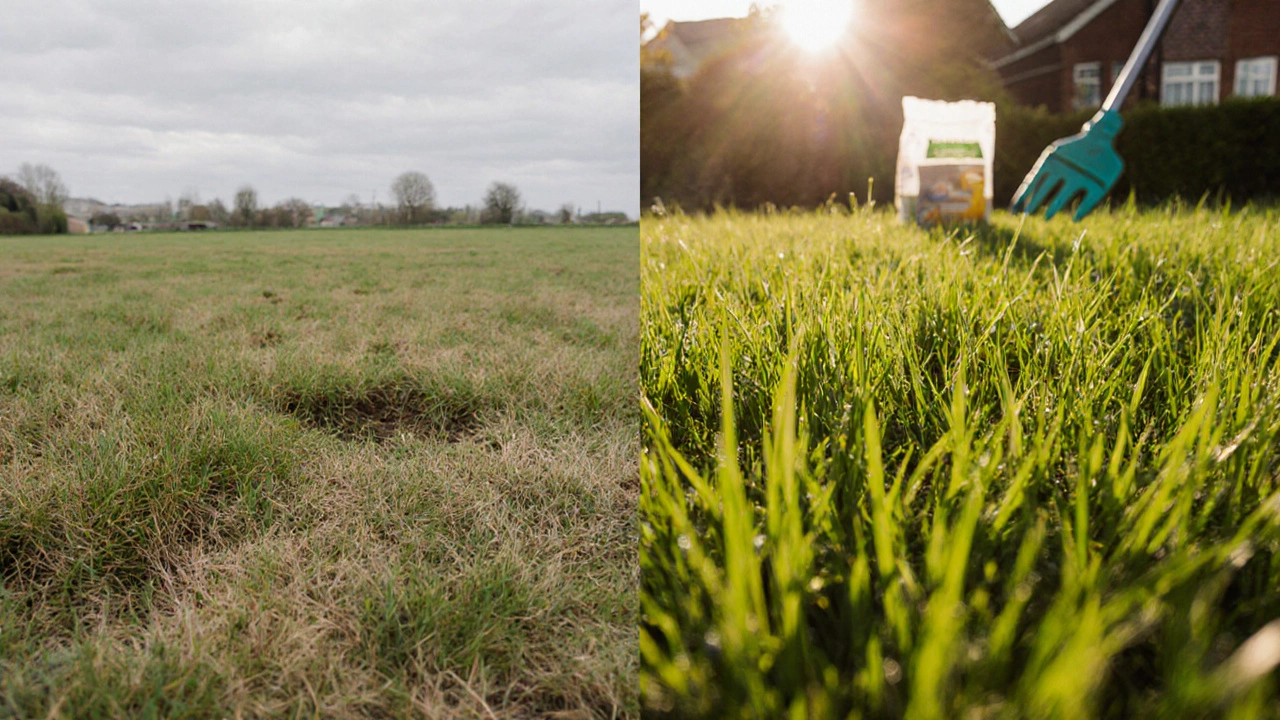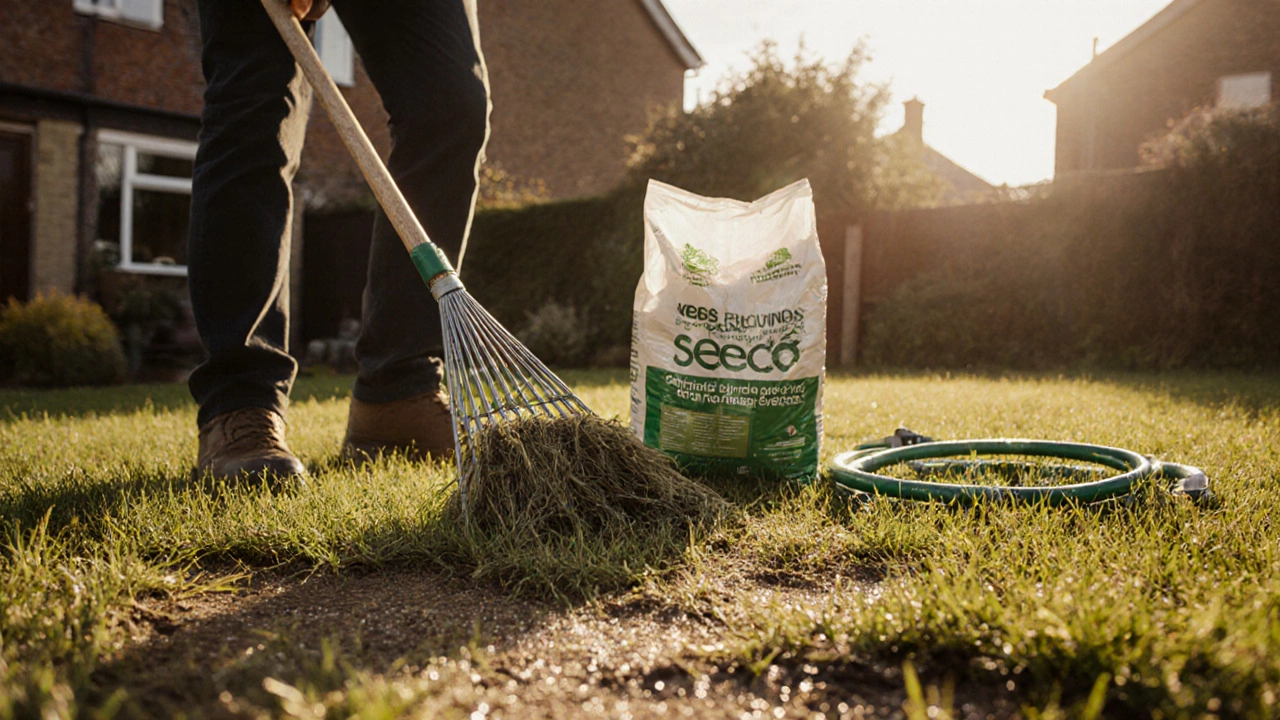Lawn Overseeding Calculator
Seed Quantity Needed
0 grams
Most lawns in the UK thin out over time. That patchy look? It’s not just bad luck. Winter frost, foot traffic, drought, or even just old grass can leave your lawn looking worn out. But you don’t need to rip it all up and start again. Overseeding is the simplest, cheapest way to bring your lawn back to life-no dig, no fuss, just better grass.
Why overseed at all?
Grass isn’t like a house. It doesn’t last forever. Even the toughest varieties-like perennial ryegrass or fine fescue-get thin. Bare spots appear. Moss creeps in. Weeds take over. Overseeding fills those gaps with new grass before they become problems. It’s not magic. It’s science. Every year, your lawn loses about 10-15% of its density naturally. Overseeding replaces that loss. In the UK, where autumn rains and cooler soil temperatures are perfect for germination, late August to mid-October is your sweet spot. Do it now, and you’ll have a thicker lawn by spring.
What you’ll need
You don’t need fancy gear. Just these basics:
- Grass seed suited to your lawn type (more on this below)
- A lawn rake or scarifier (manual or electric)
- A spreader (broadcast or drop-style)
- Compost or topsoil (optional, but helpful)
- A garden hose or watering can
- Starter fertilizer (low in nitrogen, high in phosphorus)
Don’t waste money on fancy seed blends marketed as "instant lawn." Stick to proven mixes. For most UK lawns, a blend of 70% perennial ryegrass and 30% fine fescue works best. Ryegrass germinates fast, holds up to foot traffic, and greens up quickly. Fine fescue survives shade and dry spells. Avoid annual ryegrass-it dies off in a year.
Step 1: Mow short and clear
Set your mower to its lowest setting. Cut the grass down to about 2-3 cm. This lets sunlight reach the soil and gives seeds a better chance to land where they can grow. After mowing, rake up all the clippings. Don’t leave them. They’ll smother new seedlings. If you have a lot of thatch (spongy, dead stuff under the grass), use a scarifier. Thatch thicker than 1 cm blocks water, air, and seed from reaching the soil. A powered scarifier is worth the £30 rental if you’ve got a big lawn.
Step 2: Aerate if needed
If your soil feels hard underfoot, or water pools after rain, it’s compacted. Compacted soil = no root growth. You need air pockets. Use a garden fork or a manual aerator. Push it into the ground every 10-15 cm across the whole lawn. Don’t just poke a few holes. You need at least 20-30 holes per square metre. This lets water and seed settle deep where roots need to go. Skip this step if your lawn drains well and feels spongy. But if you’ve got clay soil-common in Brighton-this is non-negotiable.
Step 3: Spread seed evenly
Measure your lawn area. Most seed packets say how much you need per square metre. For a standard UK lawn, use 25-35 grams per square metre. Too little? You’ll still have bare patches. Too much? Seedlings compete and die off. Use a spreader. If you don’t have one, walk in straight lines, scattering seed by hand. Go over the whole lawn twice-once north-south, once east-west. That way, you cover gaps. Don’t just dump seed on top of existing grass. You need seed-to-soil contact. That’s why raking and aerating came first.

Step 4: Light topdressing (optional but smart)
After seeding, spread a thin layer-no more than 5 mm-of compost or topsoil. This keeps seeds moist and protects them from birds. It also adds nutrients. Don’t bury the seed. You should still see some seed poking through. If you skip this, just water well. But if you’ve got sandy soil or live in a dry patch, topdressing cuts your watering time in half.
Step 5: Water gently and often
This is where most people fail. They water once and forget. New grass seed needs moisture every day. Not a soaking. Not a flood. Just a light mist. Think morning dew. Water twice a day-early morning and late afternoon-for 10-15 minutes each time. Keep the top 1 cm of soil damp. If it dries out even once, the seed dies. After two weeks, when you see tiny green shoots, cut back to once a day. After four weeks, water deeply once or twice a week to encourage deep roots.
Step 6: Wait before you mow
Don’t rush. Let the new grass grow to 7-8 cm before your first cut. Use the highest mower setting. Never cut more than one-third of the blade. That shock kills young plants. Use sharp blades. Dull blades tear grass instead of cutting it, leaving ragged ends that turn brown. Wait six weeks before you apply fertilizer. Too early, and the new roots burn. Use a low-nitrogen, high-phosphorus starter feed. It helps roots grow, not leaves.
What to avoid
- Overwatering: Soggy soil causes fungus and rot. If puddles form, you’re watering too much.
- Using weedkillers: Don’t apply any herbicide for at least 8-10 weeks. It kills new seedlings.
- Walking on it: Keep kids and pets off the seeded areas for the first three weeks.
- Seeding in summer: Heat and dry soil kill seed. Spring and autumn are the only good windows.
- Buying cheap seed: Seed with 5% or more weed content? Don’t touch it. Look for certified seed with 98% purity.

What kind of seed should you use?
Your soil and sun conditions decide this. Here’s a quick guide:
| Condition | Recommended Mix | Why It Works |
|---|---|---|
| Full sun, heavy use (play areas, paths) | 80% perennial ryegrass, 20% fine fescue | Fast-growing, tough, recovers from wear |
| Shady spots (under trees, north side) | 60% fine fescue, 40% creeping red fescue | Thrives in low light, drought-tolerant |
| Clay soil, wet winters | 70% perennial ryegrass, 30% chewings fescue | Resists waterlogging, good drainage |
| Low maintenance (don’t want to mow often) | 100% fine fescue | Grows slowly, needs cutting only every 3-4 weeks |
Brands like Westland, Scotts, or Suttons are reliable. Check the label for “certified grass seed” and avoid anything with “wildflower” or “meadow” mix unless you want a meadow-not a lawn.
When to expect results
You’ll see the first green shoots in 7-14 days if conditions are right. Full coverage takes 4-8 weeks. Don’t panic if it looks patchy at first. That’s normal. Grass doesn’t grow in perfect lines. It fills in unevenly. By next spring, your lawn should be noticeably thicker, greener, and more resistant to weeds and moss. If you overseed every 2-3 years, you’ll rarely need to reseed from scratch.
What if it doesn’t work?
Three common reasons overseeding fails:
- Seed didn’t touch soil. You just sprinkled it on top. Rake or aerate next time.
- Watered too little or too late. Seed dried out. Set a phone reminder to water daily.
- Wrong seed for your conditions. Put sun-loving seed in shade? It won’t grow. Match seed to light and soil.
If half your lawn still looks bare after 6 weeks, go back to step one. Rake again, re-seed, and water harder. Sometimes, you just need a second try.
Next steps after overseeding
Once your lawn is thick and green-usually by late spring-start a simple care routine:
- Mow weekly, never cutting more than one-third of the blade
- Feed with a balanced lawn fertilizer in April and September
- Aerate every 2 years if soil is heavy
- Apply lawn feed with iron in early spring to kill moss
Overseeding isn’t a one-off fix. It’s part of a rhythm. Like brushing your teeth. Do it right, and your lawn stays healthy without constant drama.
Can I overseed in spring instead of autumn?
Yes, but it’s harder. Spring seeding works if you do it early-before mid-May-and if you water daily. But summer heat kills young seedlings fast. Autumn is better because the soil is still warm from summer, but the air is cooler. Rain is more reliable, and weeds like crabgrass aren’t active yet. In the UK, autumn gives new grass 6-8 weeks to establish before frost.
Do I need to remove weeds before overseeding?
Not if you’re doing it right. Weeds won’t outcompete new grass if you seed thickly and keep the soil moist. But if you have large patches of dandelions, creeping buttercup, or chickweed, remove them by hand first. Don’t use weedkiller. Wait until your new grass is 8-10 weeks old before applying any herbicide. Then, spot-treat only.
How much seed do I need for a 50m² lawn?
For a standard UK lawn, use 25-35 grams per square metre. That means 1.25-1.75 kg total. Most bags come in 1 kg or 2 kg sizes. Buy a 2 kg bag-it’s cheaper per kg, and you’ll have extra for touch-ups. Don’t guess. Weigh it. Too little seed means patchiness. Too much leads to overcrowding and weak grass.
Can I overseed over existing moss?
No. Moss thrives where grass fails-damp, shady, compacted soil. Overseeding over moss just gives the moss more room. First, rake out the moss with a stiff brush or scarifier. Then, apply iron-based moss killer if needed. Wait 2 weeks. Then overseed. If you skip this, the moss will come back in a few months.
Should I use fertilizer when overseeding?
Yes-but the right kind. Use a starter fertilizer with high phosphorus (like 10-20-10) and low nitrogen. Phosphorus helps roots grow fast. Nitrogen makes leaves grow too fast, stressing young plants. Apply it right after seeding, not before. Don’t use regular lawn feed-it’s too strong. Look for "starter feed" on the label. Wait 6 weeks before applying anything else.
Final thought
Overseeding isn’t glamorous. It doesn’t make headlines. But it’s the single most effective thing you can do for your lawn without spending hundreds on new turf. Do it once, and you’ll save money on replacements. Do it every few years, and your lawn will outlive your neighbours’. It’s not about perfection. It’s about persistence. Keep the soil ready. Keep the seed down. Keep the water coming. The grass will do the rest.
